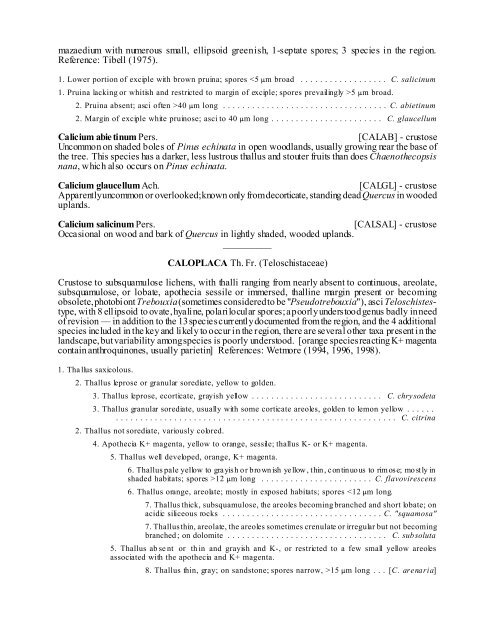lichens of the lower ozark region of missouri and arkansas
lichens of the lower ozark region of missouri and arkansas
lichens of the lower ozark region of missouri and arkansas
Create successful ePaper yourself
Turn your PDF publications into a flip-book with our unique Google optimized e-Paper software.
mazaedium with numerous small, ellipsoid greenish, 1-septate spores; 3 species in <strong>the</strong> <strong>region</strong>.<br />
Reference: Tibell (1975).<br />
1. Lower portion <strong>of</strong> exciple with brown pruina; spores 5 �m broad.<br />
2. Pruina absent; asci <strong>of</strong>ten >40 �m long .................................. C. abietinum<br />
2. Margin <strong>of</strong> exciple white pruinose; asci to 40 �m long ....................... C. glaucellum<br />
Calicium abie tinum Pers. [CALAB] - crustose<br />
Uncommon on shaded boles <strong>of</strong> Pinus echinata in open woodl<strong>and</strong>s, usually growing near <strong>the</strong> base <strong>of</strong><br />
<strong>the</strong> tree. This species has a darker, less lustrous thallus <strong>and</strong> stouter fruits than does Chaeno<strong>the</strong>copsis<br />
nana, which also occurs on Pinus echinata.<br />
Calicium glaucellum Ach. [CALGL] - crustose<br />
Apparently uncommon or overlooked; known only from decorticate, st<strong>and</strong>ing dead Quercus in wooded<br />
upl<strong>and</strong>s.<br />
Calicium salicinum Pers. [CALSAL] - crustose<br />
Occasional on wood <strong>and</strong> bark <strong>of</strong> Quercus in lightly shaded, wooded upl<strong>and</strong>s.<br />
__________<br />
CALOPLACA Th. Fr. (Teloschistaceae)<br />
Crustose to subsquamulose <strong>lichens</strong>, with thalli ranging from nearly absent to continuous, areolate,<br />
subsquamulose, or lobate, apo<strong>the</strong>cia sessile or immersed, thalline margin present or becoming<br />
obsolete, photobiont Trebouxia (sometimes considered to be "Pseudotrebouxia"), asci Teloschistestype,<br />
with 8 ellipsoid to ovate, hyaline, polarilocular spores; a poorly understood genus badly in need<br />
<strong>of</strong> revision — in addition to <strong>the</strong> 13 species currently documented from <strong>the</strong> <strong>region</strong>, <strong>and</strong> <strong>the</strong> 4 additional<br />
species included in <strong>the</strong> key <strong>and</strong> likely to occur in <strong>the</strong> <strong>region</strong>, <strong>the</strong>re are several o<strong>the</strong>r taxa present i n <strong>the</strong><br />
l<strong>and</strong>scape, but variability among species is poorly understood. [orange species reacting K+ magenta<br />
contain anthroquinones, usually parietin] References: Wetmore (1994, 1996, 1998).<br />
1. Thallus saxicolous.<br />
2. Thallus leprose or granular sorediate, yellow to golden.<br />
3. Thallus leprose, ecorticate, grayish yellow ........................... C. chrysodeta<br />
3. Thallus granular sorediate, usually with some corticate areoles, golden to lemon yellow ......<br />
.......................................................... C. citrina<br />
2. Thallus not sorediate, variously colored.<br />
4. Apo<strong>the</strong>cia K+ magenta, yellow to orange, sessile; thallus K- or K+ magenta.<br />
5. Thallus well developed, orange, K+ magenta.<br />
6. Thallus pale yellow to gra yis h o r brown ish ye llow , t hin , c on tinuo us to rim os e; mo stly in<br />
shaded habitats; spores >12 �m long ....................... C. flavovirescens<br />
6. Thallus orange, areolate; mostly in exposed habitats; spores 15 �m long ...[C. arenaria]


